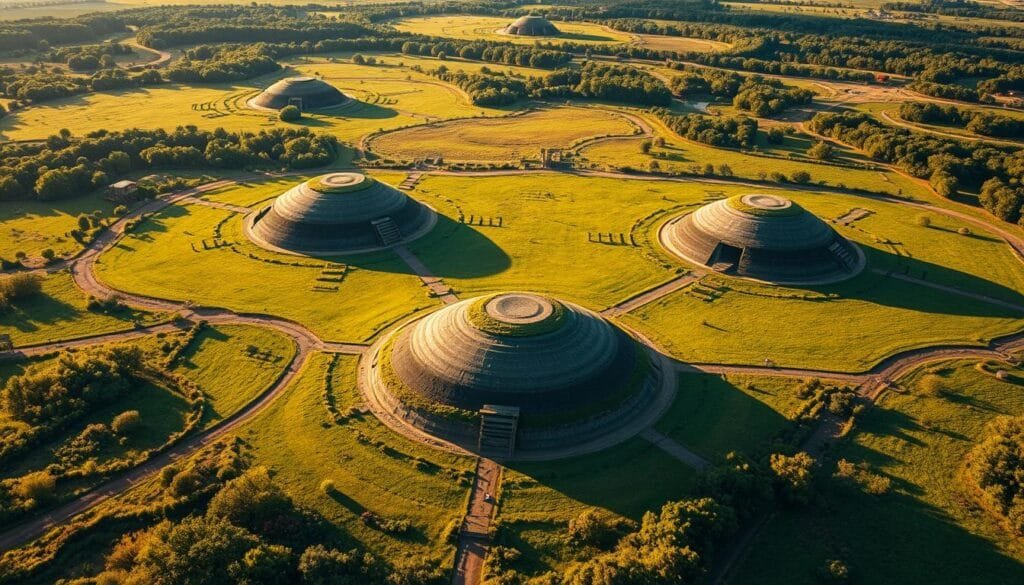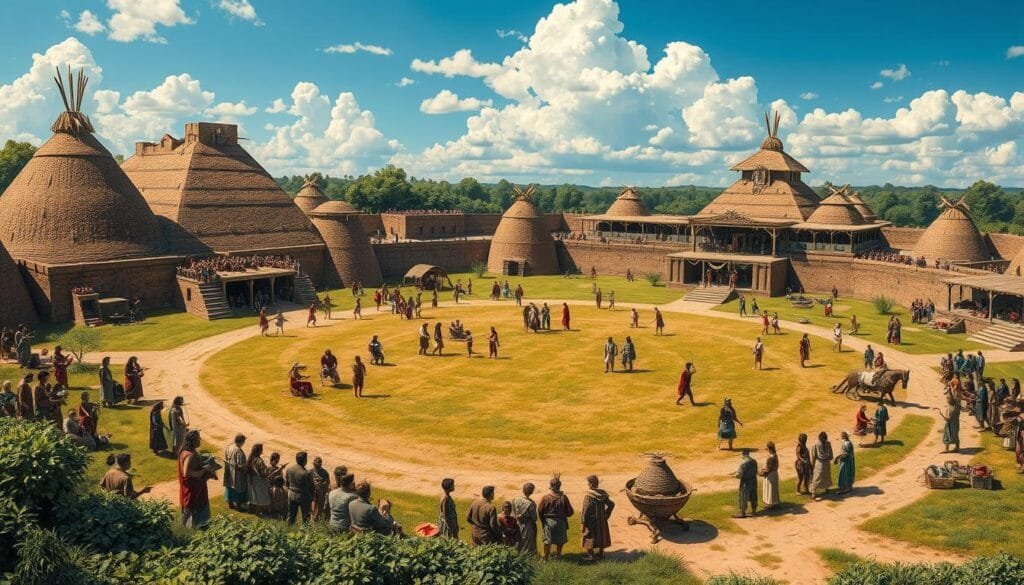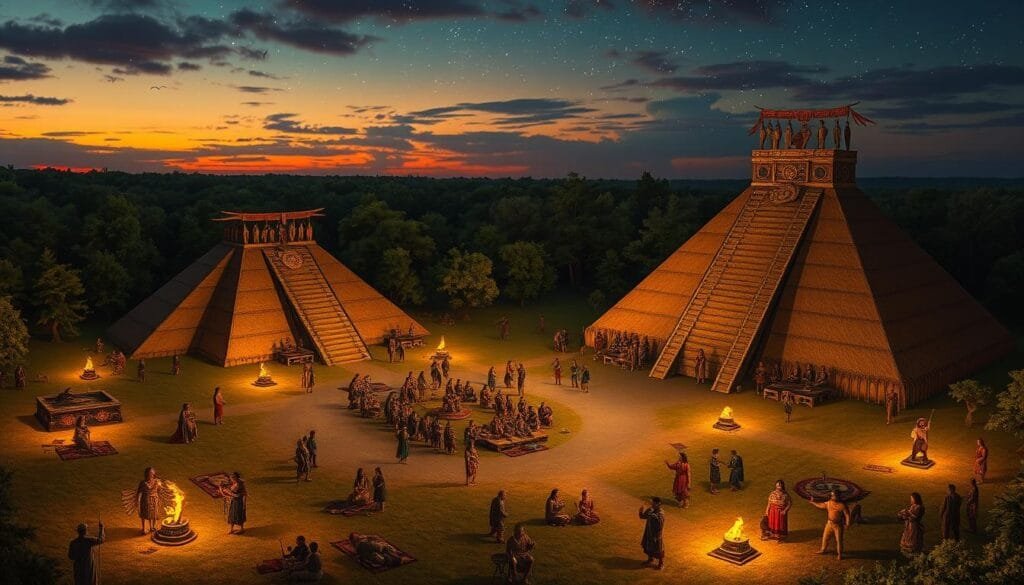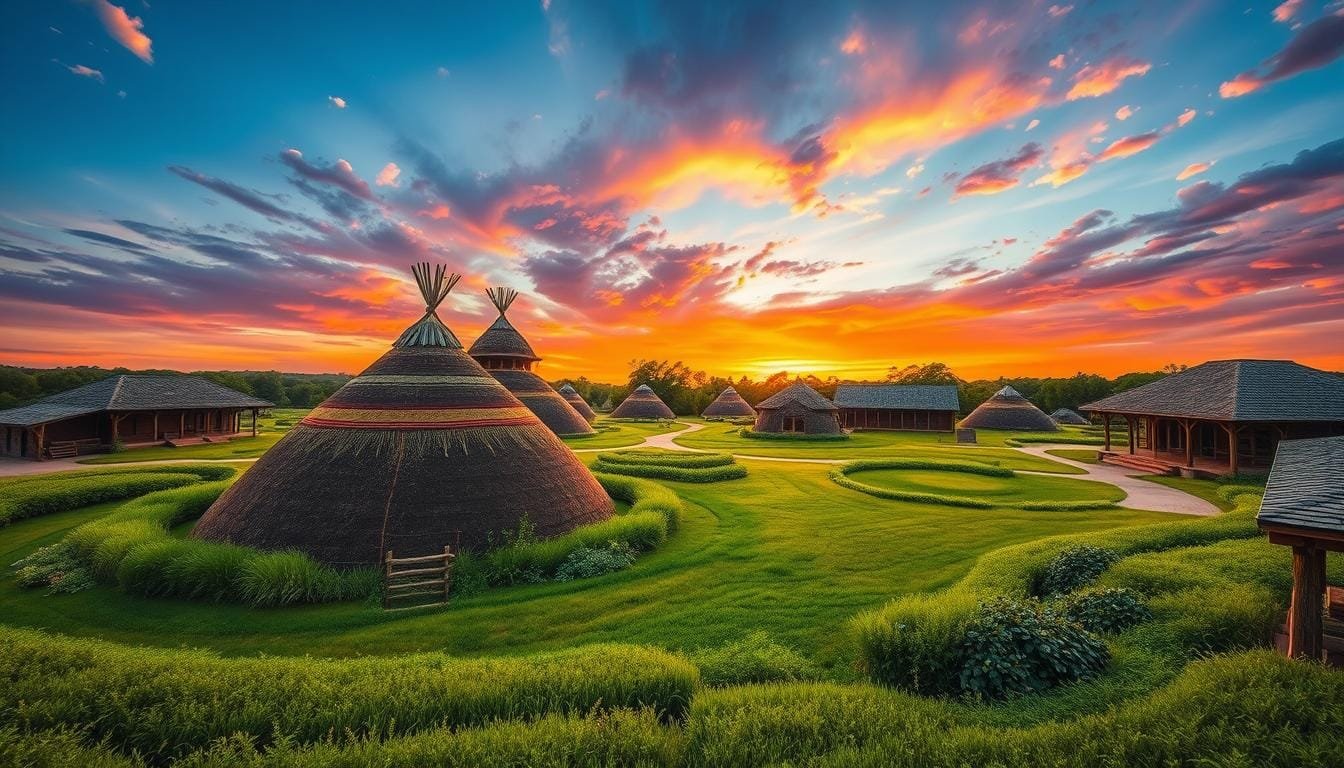Have you ever thought about how ancient societies in North America managed their lives? The key can be found in the great buildings of their ceremonial centers. We’re looking into the Mississippian culture, active from 700 CE until Europeans arrived. The ceremonial plaza stood as the community’s heart during this era.
These plazas were not just simple open areas. They were crucial for societal and religious events. This shows how important community design was in ancient North American societies.
Key Takeaways
- The Mississippian culture thrived from 700 CE until European contact.
- Central features of these societies included ceremonial plazas around which village-states were organized.
- Plazas served as the epicenter for social, political, and religious activities.
- Large population centers like Cahokia, with up to 40,000 inhabitants, underline the scale of these complex societies.
- Massive earthworks such as Monks Mound emphasize the sophisticated construction techniques employed.
- Craftwork in copper, shell, and other materials underscores a flourishing trade and craftsmanship network.
Introduction to Mississippian Culture Plazas
The Mississippian culture thrived from around 700 CE until Europeans arrived. It’s known for its unique plazas in communities. These plazas were central for ceremonies and showed the culture’s complex social systems. Let’s look closer at these plazas and how they spread widely.
Defining the Plazas
Mississippian plazas were usually at the center of settlements. They were large, open areas surrounded by mounds. These plazas were important for daily life, ceremonies, and markets.
Take Monks Mound at Cahokia, for example. It’s huge, about 1,000 feet long and 100 feet high. This shows how important plazas were to these communities.
The Spread of Mississippian Culture
Mississippian culture spread from the Mississippi River Valley to the Great Plains and Wisconsin. This expansion is seen in shared architectural styles. Plazas and mounds were central in communities across Georgia and Alabama too.
In these societies, plazas marked social and political ranks. Towns grew in river valleys, where the soil was rich for farming. This led to large, dense settlements. The plaza concept spread widely, uniting the central and southeastern United States culturally.
What Are Plazas in Mississippian Culture
The Mississippian culture began around AD 800. It is known for its well-organized towns with central plazas. These plazas were key to the community and social life of the Mississippians. By looking at these plazas, we can learn a lot about how the Mississippians planned their towns.
Structure and Layout of the Plazas
Mississippian plazas show us their urban planning skills. These plazas were surrounded by mounds and houses, making them the town’s heart. For instance, Cahokia had 120 mounds, with Monks Mound being the tallest at 290 meters. This setup was typical in Mississippian settlements, showing their advanced planning and focus on community.
Take the Etowah Mounds as an example. They cover 54 acres with 140 known structures. Its central plaza is a testament to intricate urban design. Moundville, with its 29 mounds, shows how plazas helped organize towns systematically around AD 1350.
Functions and Significance
Plazas in Mississippian culture were centers for many activities. They hosted markets, public gatherings, and big ceremonies. These events brought people together, creating a strong community bond. The plazas’ cultural significance is evident in their use for major ceremonies and as symbols of unity. For instance, Cahokia’s plaza was pivotal for up to 20,000 residents, aiding interaction and cohesion.
Mississippian plazas were bustling with life. From Cahokia’s large plaza and its 120 mounds to Angel Mounds’ 100-acre site with maize farming, these plazas were vibrant parts of Mississippian life.
| Location | Key Features | Population Peak | Mound Counts |
|---|---|---|---|
| Cahokia | 120 platform mounds, including Monks Mound | 20,000 | 120 |
| Moundville | 29 truncated earthen pyramid mounds | 1,000 (main); 10,000 (surrounding) | 29 |
| Etowah | 140 structures over 54 acres | Not specified | 140 |
| Angel Mounds | 13 earthen mounds on 100 acres | 1,000 | 13 |
The design of Mississippian plazas and their diverse roles highlight their importance in Mississippian society. They show us the advances in town planning. These practices contributed to lasting cultural significance and social unity.
Architectural Features of Mississippian Plazas
Mississippian plazas were a mix of homes, ceremonial sites, and large earthen mounds. These elements were the heart of the community, showing their complex society.
Mounds and Their Importance

Mississippian mounds were key to their culture. They were big not just in size but in meaning too. At the top, you’d often find significant buildings or leaders’ homes. This showed the mix of politics and religion clearly.
Take Lamar’s site, for example. It has two big mounds, one even with a spiral ramp. This shows their creativity and the deep meaning of these structures.
Residential and Ceremonial Buildings
Near the mounds, there were homes and places for ceremonies. These buildings show the social layers within the Mississippian culture. One Earth Lodge, for instance, had a special floor with 47 seats. It also had three more seats on a bird-shaped platform. This design was all for supporting their rituals and marking different statuses.
The mix of homes and ceremonial buildings in plazas was vital. It was central to both everyday life and religious events. The design of Mississippian plazas was deeply tied to their complex social structure.
The Role of Plazas in Social and Political Life
Plazas were central to the ancient societies in Mississippian chiefdoms. They shaped social and political structures. At these communal spaces, everyone from rulers to commoners gathered.

These plazas were not just empty spaces. They were where the elites and commoners interacted. This was key for keeping the political structure of chiefdoms in check. For example, the central plaza in Cahokia covered about 200 acres. It was a hub for both community and ritual events.
The social setup of Mississippian chiefdoms is seen in their plazas. In places like Cahokia, elite families lived on mounds, showcasing social tiers. Through communal gatherings, the elite displayed wealth and power. This reinforced their top positions.
Plazas also hosted social events, building community and identity. They were places for trade, religious ceremonies, and public celebrations. This made them key social spots. The central plaza of Cahokia is a great example of this role.
Understanding Mississippian plazas shows their design served many purposes. From governance to trade, these sites were cultural and political hotspots. Chiefdoms like Cahokia and Aztalan highlight the plazas’ importance for social harmony and structure.
| Feature | Details |
|---|---|
| Central Plaza Size | Approx. 200 acres at Cahokia |
| Main Activities | Communal gatherings, trade, civic deliberations |
| Social Hierarchy | Elites on mounds, commoners on lower ground |
| Economic Contributions | Marketplace and diverse vendor activities |
| Architectural Evolution | From Spanish colonial to antebellum styles |
| Preservation Efforts | Ongoing by historical societies |
Religious and Ceremonial Uses of Plazas
Mississippian plazas were vital for everyday life and for religious events. They were places where people came together for rituals. These rituals helped strengthen the community and its leaders.
Chiefs and priest-rulers were key figures in these ceremonies. They connected the people to the spiritual world. Their roles were both spiritual and as leaders.

Chiefs and Priest-Rulers
Chiefs played a big role in Mississippian culture, especially in religion. They were seen as sacred, leading rituals to keep order and norms. Their jobs were more than just leading; they held spiritual significance.
Priest-rulers also had important roles in spiritual activities. They performed specific rituals. These rituals linked the community to their ancestors and gods.
Public Gatherings and Rituals
The plazas were places where everyone gathered for important ceremonies. These events involved the whole community in religious activities. They included feasts, dances, and various rites.
Such events were tied to the agricultural calendar, stars, and honoring deceased chiefs. They were crucial for keeping the community and its traditions alive.
Plazas in Mississippian culture were carefully designed for these purposes. For more on their social and religious roles, including chiefs, see this detailed resource.
Conclusion
Looking into Mississippian plazas lets us see the deep levels of their society. We find out about their social, political, and religious life. These plazas show us their skill in building and how they were used in daily life.
These places were central to Mississippian communities. They hosted important events and were used for farming and managing their society. For example, Cahokia showcases the greatness of Mississippian settlements. It has huge mounds and complex buildings that tell us about their legacy.
The north plaza of Cahokia, surrounded by mounds, reveals how they viewed the world. This place where water and sacred spaces met shows us how they connected with their environment. Understanding this helps us grasp what they valued in society.
So far, we’ve only uncovered a small part of Cahokia. However, these discoveries have greatly improved our knowledge of their culture. Research supported by groups like the National Geographic Society helps us learn more.
These efforts help keep the culture of the Mississippians alive for future generations. By studying these places, we pay tribute to a highly sophisticated prehistoric culture in North America.
FAQ
What were the defining features of Mississippian culture plazas?
Mississippian culture plazas were crucial parts of their society. These open spaces were surrounded by earthen mounds, homes, and special buildings. They were used for social, political, and religious events.
How did the Mississippian culture spread across North America?
The Mississippian culture reached far across North America. It went from the Mississippi River Valley to Wisconsin and the Great Plains. The spread of this culture was marked by the common use of plazas.
What was the structure and layout of Mississippian plazas?
Mississippian plazas had large open spaces. Around them were mounds with temples or homes for leaders, along with other buildings. These spaces were used for meetings, ceremonies, and markets.
Why were the mounds in Mississippian plazas important?
The mounds in Mississippian plazas showed political and religious power. With temples or leaders’ homes on top, they marked the very important structure of their society.
What role did plazas play in Mississippian social and political life?
Plazas were the heart of social and political life in Mississippian cultures. They were places for key meetings, social events, and showed the social order. This supported their chiefdom-based politics and social layers.
How were plazas used for religious and ceremonial purposes in Mississippian culture?
Plazas were key for religious events in Mississippian culture. Led by chiefs and priest-rulers, they held public rituals and gatherings. This reinforced their religious beliefs and community bonds.
